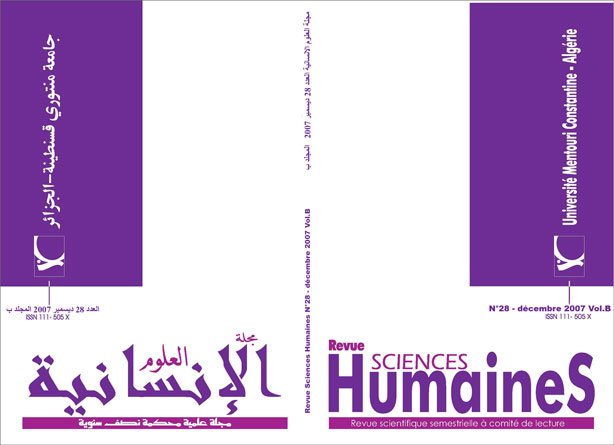Grammar Consciousness-Raising Tasks VS Traditional Grammar Lessons for Developing Explicit Knowledge and Accuracy
الملخص
This article attempts to compare the effects ‘Grammar Consciousness-Raising Tasks’ and ‘Traditional Grammar lessons’ on the acquisition of English tenses in terms of gains in explicit knowledge and grammatical accuracy. The study shows that the results of the students who follow the innovative materials overwhelm those who follow the traditional grammar lessonsالتنزيلات
المراجع
Batstone, Rob.1994a. Grammar. Oxford: OUP.
Benati, Alessandro. 2001. A comparative study of the effects of processing instruction and output-based instruction on the acquisition of the Italian future tense. Language Teaching Research, 5/2: 95-127.
Bialystok, Ellen. 1981. The role of linguistic knowledge in second language use. Studies in Second Language Acquisition, 4/1: 31-45.
Bialystok, Ellen. 1982. On the relationship between knowing and using linguistic forms. Applied Linguistics, 3/3: 181-206.
Breen, Michael P. 1989. The evaluation cycle for language learning tasks. In R. K. Johnson (Eds.), The Second Language Curriculum, (pp. 187-206). Cambridge: CUP.
Candlin, Christopher N. 1987. Towards task-based language learning. In C. N. Candlin and D. Murphy (Eds.), Lancaster Practical Papers in English Language Education: Vol.
Language Learning Tasks, (pp.5-22). Englewood Cliffs, NJ.: Printice Hall.
Douglas, Brown H. 1994. Teaching Principles: An Integrative Approach to Language Pedagogy. Englewood Cliffs, New Jersey: Printice Hall Regents.
Ellis, Rod. 1990. Instructed SLA: Learning in the Classroom. Oxford: Blackwell. Ellis, Rod. 1992. Second Language Acquisition and Second Language Pedagogy.
Clevedon: Multilingual Matters Ltd. Ellis, Rod.1998. Evaluating and researching grammar consciousness-raising tasks.
In P. Rea-Dickins and K. P. Germaine (Eds.), Managing Evaluation and Innovation in Language Teaching, (pp. 220-252). London: Longman.
Ellis, Rod. 2003. Task-based Language Learning and Teaching. Oxford: OUP. Fotos, Sandra, S. 1993. Consciousness-raising and noticing through focus on form: Grammar task performance versus formal instruction. Applied Linguistics, 14/4: 385-407. Fotos, Sandra S. 1994. Integrating grammar instruction and communicative language use through grammar consciousness-raising tasks. TESOL QUATERLY, 28/2: 323-351. Fotos, Sandra S. and Ellis, Rod. 1991. Communicating about grammar: A task based approach. TESOL QUATERLY, 25/4: 605-628. Freeman, Simon. 1983. Progressions: English Grammar in Context. London: Evans Brother Ltd. Hood, Philip. 1994. Communicative grammar: a practical problem-solving approach ? Language Learning Journal, 9: 28-31. Johnson, Karen E. 1995. Understanding Communication in Second Language Classrooms. Cambridge: CUP. Krashen, Stephen D.1981. Second Language Acquisition and Second Language Learning. London: Printice Hall International. Krashen, Stephen D. 1987. Principles and Practice in Second Language Acquisition. New York: Printice Hall International. Long, Michael H. 1983. Native speaker/non native speaker conversation in the second language classroom. TESOL QUATERLY, 82: 207-225.
Nunan, David. 1989a. Designing Tasks for the Communicative Classroom. Cambridge: OUP.
Nunan, David. 1991a. Language Teaching Methodology: A textbook for Teachers. London: Printice Hall International. Pica, Teresa; Kanagy, Ruth and Falodun, Joseph. 1993. Choosing and using communication tasks for second language instruction and research. In G. Crookes and S. M. Gass (Eds. 1993a), pp. 9-34. Prabhu, N.S. 1987. Second Language Pedagogy. Oxford: OUP. Richards, Jack C. 1999. Addressing the grammar-gap in task work. Prospect (A Journal of Australian TESOL), 14/1: 4-19. Servan-Schreiber, Emile and Anderson, John, R. 1990. Learning artificial grammars with competitive chunking. Journal of Experimental Psychology: Learning, Memory, and Cognition, 16/4: 592-608. Swain, Merrill. 1985. Communicative competence: Some roles of comprehensible input and comprehensible output in its development. In S. Gass and C. Maden (Eds.), Input and Second Language Acquisition, (pp. 235-253). Rowley, M.A.: Newbury House. Swain, Merrill.1998. Focus on form through conscious reflection. In C. Doughty and J. Williams (Eds.), Focus on Form in Classroom Second Language Acquisition, (pp. 64- 81).Cambridge: CUP.

















